![[Ítzi, the iceman, iceman, stone age, pictures, images frozen body, alps]](archaeologist.gif)
frozen fritz, Ítzi, the iceman, iceman, stone age, pictures, images, oetzi reconstruction
Otzi, the iceman, iceman, archaeology, pictures, images oetzi, Ítzi![[Ítzi, the iceman, iceman, stone age, pictures, images frozen body, alps]](archaeologist.gif) frozen fritz, Ítzi, the iceman, iceman, stone age, pictures, images, oetzi reconstruction |
| Home > Archaeology > Otzi the Iceman from the Alps pictures images |
|
Otzi / Oetzi - The Iceman of the Alps pictures imagesOn Thursday, September 19, 1991, at about 1.30 p.m. on a sunny afternoon Erika and Helmut Simon, from Nuremberg in Germany, were enjoying the last day of a vacation half-walking and half-climbing through difficult icy and rock-strewn terrain high up on a mountain overlooking the Ötz valley in the Alpine borderlands between Austria and Italy. On their descent from a peak near Tisenjoch they strayed a little from
the recommended route in the hope of finding a short cut and, as they traversed a rock-strewn elevated plateau near a retreating mountain glacier
at some 3210 meters above sea level, they passed a gully filled with thawing ice and
melt-water within which they noticed something unusual. Further investigation showed this object, which Helmut Simon at first, and from a little distance, thought to be a "doll's head",
to be an actual human corpse.
On their descent from a peak near Tisenjoch they strayed a little from
the recommended route in the hope of finding a short cut and, as they traversed a rock-strewn elevated plateau near a retreating mountain glacier
at some 3210 meters above sea level, they passed a gully filled with thawing ice and
melt-water within which they noticed something unusual. Further investigation showed this object, which Helmut Simon at first, and from a little distance, thought to be a "doll's head",
to be an actual human corpse.
Much of these human remains lay under the ice and melt-water but the back of the head and upper back and shoulders were exposed - the Simons also noticed several pieces of rolled-up tree bark near the body and took a picture of what they now presumed to be the unfortunate victim of some sort of, quite recent, accident on the mountain before leaving to report their find at a nearby hiker's shelter. No more pictures were taken that day because their camera used rolls of photographic film and when they discovered the body their camera's roll of film was nearly used up. The Simons' story featured some years later on "Death of the Iceman" an episode of the BBC2 "Horizon" popular science show first shown 9.00pm Thursday 7 February 2002. ERIKA SIMON: My husband walked in front of me a bit and then suddenly he stopped and said look at what's lying there and I said oh, it's a body. Then my husband took a photograph, just one, the last we had left in the camera.
The following day, an Austrian policeman arrived by helicopter and attempted, with the assistance of a mountain rescue keeper, to free the body with a pneumatic jackhammer. The task was made difficult by the presence of quantities of icy melt water and the powerful tool they were using actually chewed up the Iceman's garments and even ripped into his left hip, exposing the bone. In the event this recovery attempt was curtailed as the pair ran out of compressed air to power the jackhammer. A curiously-fashioned axe they discovered near the corpse was taken to a gendarmerie post in Sölden. The Austrian authorities decided to wait until the following week to resume the recovery; the helicopter, they explained, was needed for more important things. Over following days word of the discovery spread and several persons whose curiousity had been aroused proceeded to the discovery site. Many items were recovered by the mountain rescue worker who returned to the site on Sunday 22 September. One of the on-lookers used a pickaxe in further attempts to free the body from the melting ice. Overnight, however, the temperature dropped. By the time Innsbruck forensics expert Dr. Rainer Henn arrived to investigate the death, on Monday, Sept. 23, the body was again locked in ice. Having neglected to bring tools, Henn and his team resorted to hacking it out with a borrowed ice pickaxe and ski pole.
Fatalities occur every year in the high alps due to such things as climbing accidents, exhaustion, adverse weather or sudden deaths. The bodies of such victims are often recovered shortly afterwards but they can also subsequently disappear into the snowy landscape. Although some eight bodies had already been recovered from the high alps already in 1991 an archaeological expert was called in to give advice in this particular case because some of the artifacts discovered with the body seemed to be potentially very ancient. It was only then, after five days of heavy-handed mistreatment, that the Iceman was given professional assessment. Arriving at the Institute of Forensic Medicine, Konrad Spindler, head of Innsbruck's Institute for Prehistory, was stunned, immediately realizing the significance of the shriveled body. "I thought this was perhaps what my colleague Howard Carter experienced when he opened the tomb of Tutankhamen and gazed into the face of the Pharaoh."  By the time Dr. Spindler arrived at the Institute of Forensic Medicine the Iceman's remains had become the centerpiece of an informal press conference.
While the Iceman and his some of his tattered belongings lay on a dissecting table under blazing lights, reporters and other hangers-on
joked, smoked and even touched the body. Not until late afternoon did someone notice a fungus spreading on the Iceman's skin. By the time Dr. Spindler arrived at the Institute of Forensic Medicine the Iceman's remains had become the centerpiece of an informal press conference.
While the Iceman and his some of his tattered belongings lay on a dissecting table under blazing lights, reporters and other hangers-on
joked, smoked and even touched the body. Not until late afternoon did someone notice a fungus spreading on the Iceman's skin.
To prevent further damage, the body was bathed in fungicide, wrapped in a sterilized plastic sheet, covered with chipped ice and moved it to a refrigerated room at the university. There, except for 30-minute intervals when it was subsequently removed for CAT scans and other scientific tests, the Iceman was stored at 98% humidity and -6 degrees C (21.2 degrees F), the glacial temperature that it had grown accustomed to over the many, many, years prior to its discovery. Given this realisation of extreme archaeological significance the gully in which Otzi had been found was thoroughly investigated - - a process which involved much melting of ice. The various official and unofficial attempts at freeing the frozen body from the ice had, unfortunately, done harm which tended to somewhat lessen the potential archaeological value of the site. Numerous pieces of leather and hide, string, straps and clumps of hay were recovered and preserved for further study. International complications came into play as, although the body was discovered in a place where waters as they drained from this part of the Alps flowed towards Austria, its actual resting-place was confirmed, by a subsequent border survey of early October, to have been some 93 metres inside the Italian border. Agreements were reached between the relevant authorities allowing for the continued responsibility for the investigation of the corpse to lie with the Forensic Institute at Innsbruck. A dispute about "ownership" of Ötzi the Iceman, as the remains became known in an emerging world-wide fascination with this "cold case" of an ice mummy found on the Austrian-Italian frontier, continued for six years until, early in 1998, under armed guard, (because some Austrians had shown dis-satisfaction to see this relocation), Otzi and his belongings were transported from the Institute of Anatomy of the University of Innsbruck over the Brenner Pass to a new and purpose-built refrigerated resting place in a converted former bank building selected for its favourable location in the historical center of Bolzano - of an important town within Italy that was reasonably close to the actual discovery site: the conversion cost some €8,800,000 then roughly equivalent to $10,000,000. |
|
||||||||||||||||||||||||
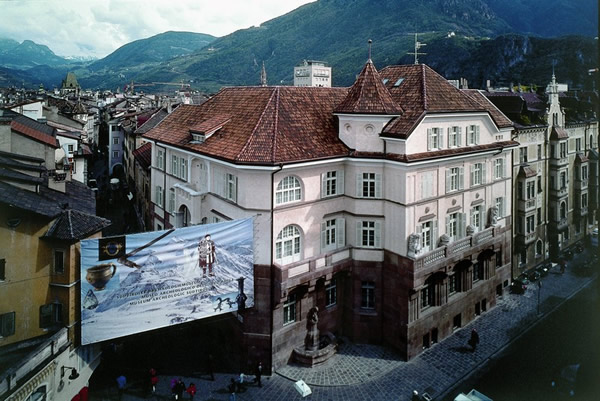
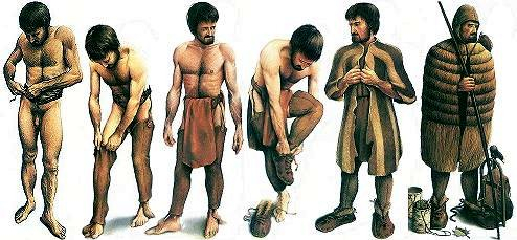
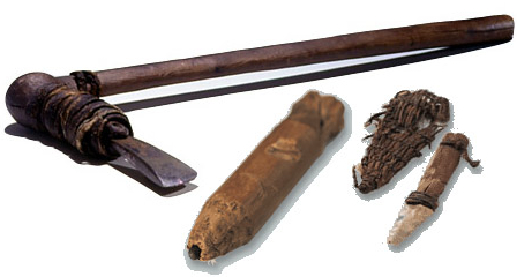
 This example of a retoucheur is an approximately 12 cm-long pencil-like tool for working with flint
was made from a piece of
lime branch which was shaped to a point at one end. At the pointed end an approximately 6 cm-long rod was driven
into the central canal, leaving a few millimetres protruding. The rod turned out to be the fire-hardened point of
a stag's antler.
This example of a retoucheur is an approximately 12 cm-long pencil-like tool for working with flint
was made from a piece of
lime branch which was shaped to a point at one end. At the pointed end an approximately 6 cm-long rod was driven
into the central canal, leaving a few millimetres protruding. The rod turned out to be the fire-hardened point of
a stag's antler. As to the tattoos - one of several groups of vertical lines are located to the left and right of the spinal column.
Others are on the left
calf,
on the right instep and on the inner and outer ankle joint, two further lines cross the left wrist. A cross-shaped mark
appears on the back of the right knee and beside the left Achilles tendon.
As to the tattoos - one of several groups of vertical lines are located to the left and right of the spinal column.
Others are on the left
calf,
on the right instep and on the inner and outer ankle joint, two further lines cross the left wrist. A cross-shaped mark
appears on the back of the right knee and beside the left Achilles tendon.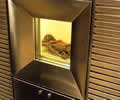 The remains of Ötzi the Iceman now lie in the Südtiroler Archeologiemuseum in Bozen / Bolzano in Italy's
South Tyrol
where they are stored in a nitrogen rich atmosphere under conditions of controlled temperature and humidity,
which are designed to guarantee a constant temperature of -6 degrees Centigrade and a relative humidity of 98%,
for their preservation but can be
seen through a 40cm x 30cm viewing window by interested visitors.
The remains of Ötzi the Iceman now lie in the Südtiroler Archeologiemuseum in Bozen / Bolzano in Italy's
South Tyrol
where they are stored in a nitrogen rich atmosphere under conditions of controlled temperature and humidity,
which are designed to guarantee a constant temperature of -6 degrees Centigrade and a relative humidity of 98%,
for their preservation but can be
seen through a 40cm x 30cm viewing window by interested visitors.
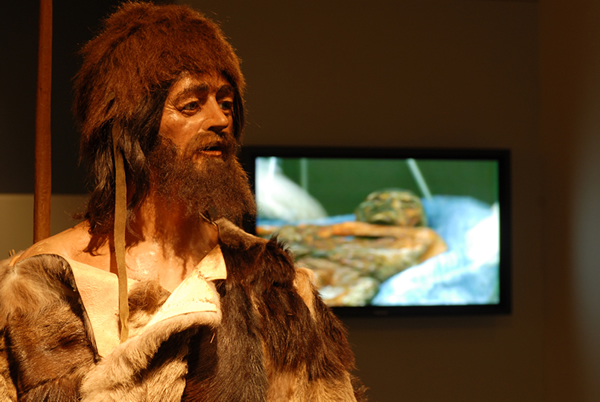
 2011 was the 20th anniversary year of the Iceman discovery.
2011 was the 20th anniversary year of the Iceman discovery. 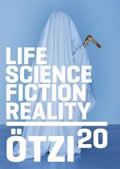 A major series of events was planned for an extensive Ötzi exhibition
is to be mounted at
the South Tyrol Archaeology Museum in Bolzano beginning on 1st March 2011 and to be continued until 15th January 2012.
A major series of events was planned for an extensive Ötzi exhibition
is to be mounted at
the South Tyrol Archaeology Museum in Bolzano beginning on 1st March 2011 and to be continued until 15th January 2012.
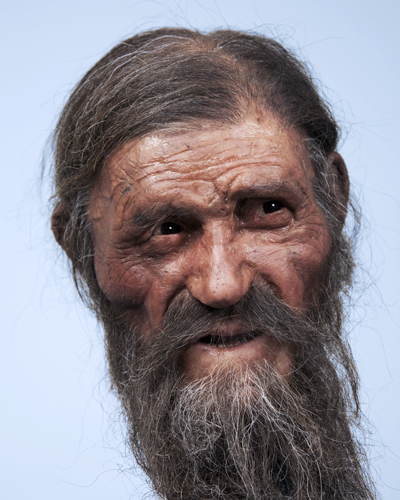
Heike Engel-21Lux / Südtiroler Archäologiemuseum / National Geographic Deutschland
A reconstruction of the face and head of Otzi the Iceman as
created by Dutch forensic experts Alfons and Adrie Kennis.
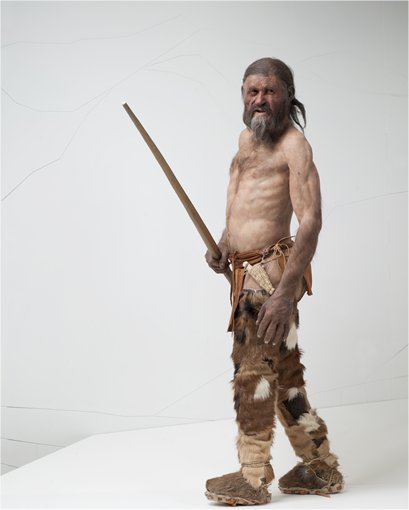
Reconstruction by Kennis © South Tyrol Museum of Archaeology / Foto Ochsenreiter
The new reconstruction offers a vivid interpretation of Otzi as a late stone-age / early copper-age hunter.
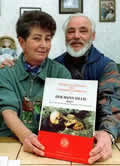 In 1994 the Italian authoritiies
offered a "symbolic" reward of 10 million lire (5,200 Euros), to the Simons, (pictured left), for their part in Oetzi's discovery and recovery.
In 1994 the Italian authoritiies
offered a "symbolic" reward of 10 million lire (5,200 Euros), to the Simons, (pictured left), for their part in Oetzi's discovery and recovery.
![]()
"...man is a bundle of relations, a knot of roots,
whose flower and fruitage is the world..."
Ralph Waldo Emerson
![]()
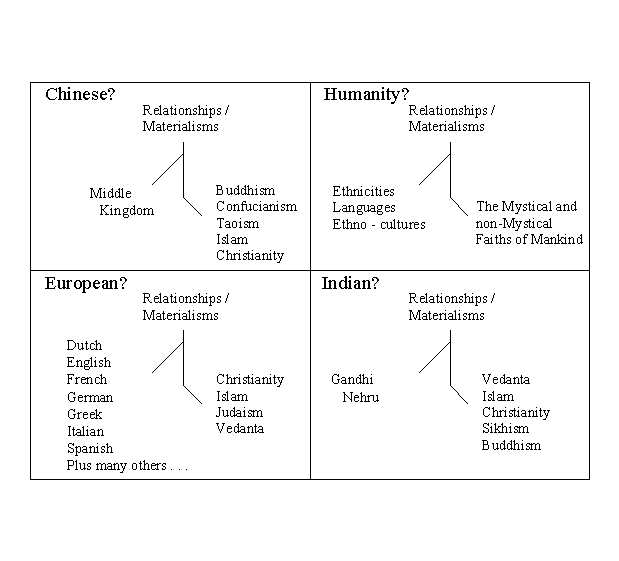
It seems highly likely that such Human-innate
"bundles of relations and knots of roots"
give rise to the "World" of Human Societies!!!
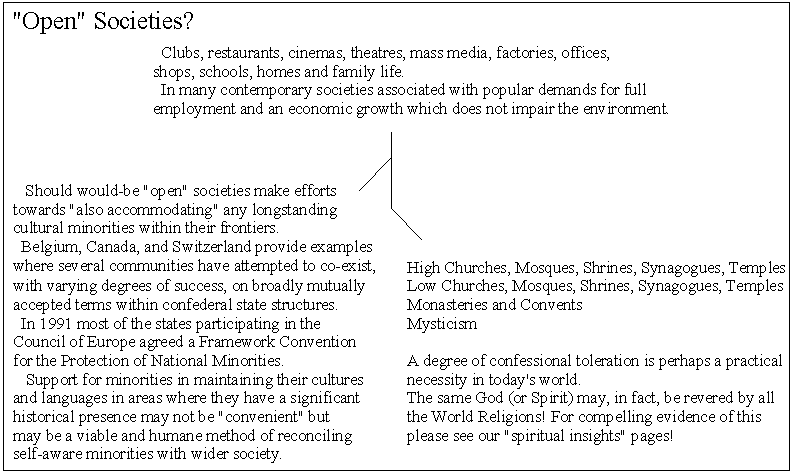
|
Return to start of
Otzi - The Iceman from the Alps pictures images page